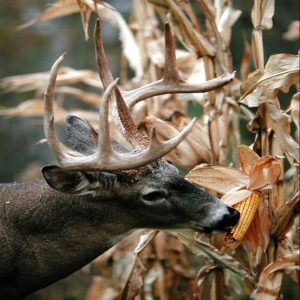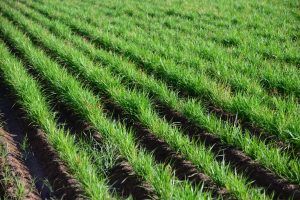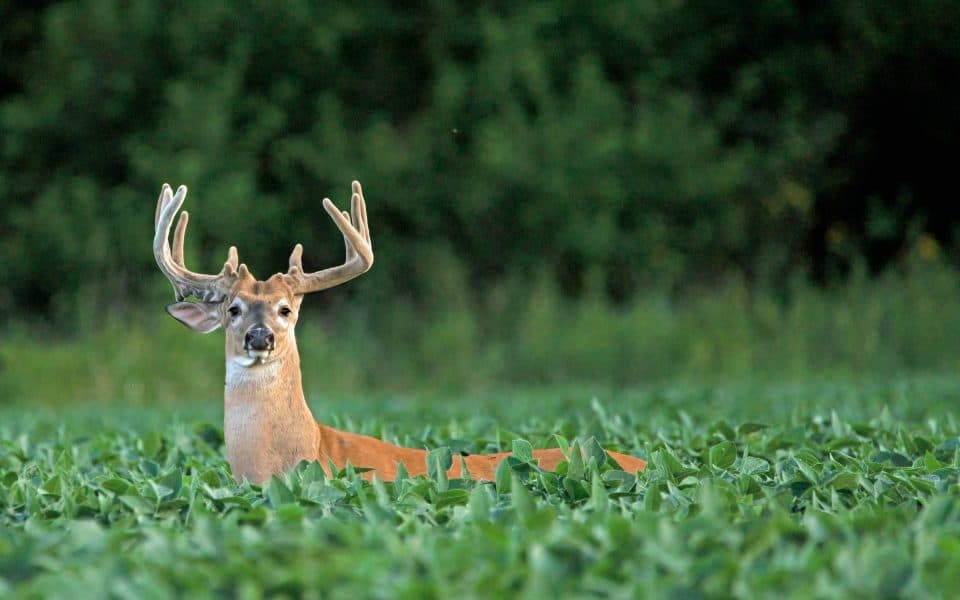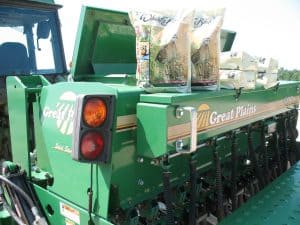A goal for all gamekeepers and hunters is improving habitat for wildlife by planting successful food plots. Spring and summer are critical months in a whitetail’s life, bucks are rebuilding their bodies from a rigorous winter and starting the amazing antler genesis process. Does have the task of eating for two or three, as most of them are carrying fawns to be born later in summer. Consistent, protein-rich food sources are key to helping your deer reach their potential.
Turkey, quail and other game birds are nesting and raising their young and are in need of good cover and seed producing plants that also attract insects. By taking advantage of the several warm season food plot options available, you will give your wildlife the nutrition they need during the critical growing months.
Wildlife Sweet Corn
 BioLogic’s Wildlife Sweet Corn is a blend of three varieties of conventional, open-pollinated (think heirloom) corn that have over a century of proven reliability. BioLogic’s Wildlife Sweet Corn has a sugar content higher than that of new hybrids, and is generally consumed earlier in the fall/winter especially when planted in areas with surrounding agricultural corn. The higher protein and nutrient content of this “sweet” corn is a major bonus for your wildlife. These proven, open-pollinated varieties of corn are non-GMO, and are not glyphosate resistant, but can be paired with conventional corn herbicides.
BioLogic’s Wildlife Sweet Corn is a blend of three varieties of conventional, open-pollinated (think heirloom) corn that have over a century of proven reliability. BioLogic’s Wildlife Sweet Corn has a sugar content higher than that of new hybrids, and is generally consumed earlier in the fall/winter especially when planted in areas with surrounding agricultural corn. The higher protein and nutrient content of this “sweet” corn is a major bonus for your wildlife. These proven, open-pollinated varieties of corn are non-GMO, and are not glyphosate resistant, but can be paired with conventional corn herbicides.
Wildlife Sweet Corn needs 90 to 100 days of warm growing to reach maturity and maximum yield. Plant it during late April to early June for the South, early May through early June for the North.
Corn should be planted at 1.5 to 2 inches deep. Planters and no-till drills are ideal for planting if available. Corn can also be broadcast planted into a well-prepared seedbed. Corn seed should be covered to the suggested depth by using a drag harrow or by lightly disking it in. Ideally, the field can also then be cultipacked or rolled for increased seedling survival. As a bonus, this sweet corn is awesome to take home a few ears to feed your family!
Clover Plus
Few plants are more effective at attracting whitetail and turkey than clover. BioLogic’s Clover Plus is a perennial blend of our New Zealand Red and White clovers and extremely successful varieties of chicory. Developed specifically for a whitetails digestive system, Clover Plus produces larger, more succulent leaves and thinner stems for higher nutritional value and improved digestibility. Both clover and chicory are extremely hardy and drought-resistant, yielding consistent production through the hot months of summer. It’s a combination of high nutrition, great attraction and consistent growth that deer can’t resist.
In the south, plant Clover Plus in the early fall, as soon as soil moisture is sufficient for seed germination. Spring planting isn’t recommended; frequent summer drought conditions could limit root growth. In the north, plant Clover Plus in the spring when soil temperature is 50° F or higher and soil moisture is sufficient. Fall planting isn’t recommended; frost may occur before root systems are established. This blend can also be frost-seeded in the spring.
Clover Plus is best planted by spreading on a well-prepared seedbed at 9 lbs. per acre, then using a cultipacker or light drag to cover the seed. Grasses can be controlled in Clover Plus using a grass specific herbicide such as clethodim.
Spring Protein Peas
 BioLogic Spring Protein Peas is an annual warm season planting that is designed to provide maximum nutrition for your deer herd through the critical growing months. Protein Peas is a very drought and browse tolerant planting that grows in a wide variety of soil types and is great for hot climates. In areas of high deer density, Protein Peas may need protection with a plot protector so plants can become established. Warm season legumes are a fantastic summer food plot. They are very versatile and will grow in a wide variety of soil types in just about every part of the country.
BioLogic Spring Protein Peas is an annual warm season planting that is designed to provide maximum nutrition for your deer herd through the critical growing months. Protein Peas is a very drought and browse tolerant planting that grows in a wide variety of soil types and is great for hot climates. In areas of high deer density, Protein Peas may need protection with a plot protector so plants can become established. Warm season legumes are a fantastic summer food plot. They are very versatile and will grow in a wide variety of soil types in just about every part of the country.
Highly palatable to deer, legumes offer a wealth of protein and digestible nutrients. Legumes also offer the land manager a huge advantage since they produce their own nitrogen and are great soil builders. Protein Peas also are easy to keep free of competing and invasive grasses using a grass specific herbicide like clethodim.
Spring Protein Peas can be planted anytime in the spring or summer months. For maximum forage output, plant in the spring two to three weeks after the last frost for your region when soil temperatures reach 60° F.
Spring Protein Peas can be broadcast onto a well prepared seed bed and covered to one inch. Seeds left on the soil surface may have poor germination and be eaten by pests. Without a current soil test to go by, fertilize with 200 to 300 lbs. per acre of 0-20-20 or a comparable low or no nitrogen fertilizer.
This blend can also be planted with a no-till drill or similar planters ― use the setting for small peas at 30 to 35lbs per acre. Set planting depth to 1 inch. Spring Protein Peas can be sprayed with grass specific herbicides to kill any grass competition in the plot.
 WhistleBack
WhistleBack
This same principal of proper timing and planning applies for other plantings for doves, ducks, pheasants, etc. Planting areas specifically for birds is beneficial for a property not just from a hunting standpoint. Oftentimes these plantings are used in strips or transition zones adjacent to food plots for deer. The step down effect from timber to grassy seed producing plants to lower growing “green groceries” creates diversity and makes for awesome wildlife habitat including a lot of small mammals, song birds, and insects.
BioLogic’s WhistleBack is a warm season blend of sorghum, millets, and sunflowers. This mix is designed to produce massive amounts of seed, and at the same time offer cover for many species of upland birds. This blend contains varieties that all grow and mature at different heights, offering food to birds as small as quail and doves on up to pheasants or turkeys.
Ideally plant WhistleBack during late spring and early summer. The plants in in this blend are designed to grow and mature by the end of the summer. The seeds will shatter and naturally distribute on the ground, when birds throughout the fall and winter will consume them.
Sorghums, millets, and sunflowers all require the same basic planting depth and ground preparation should be as follows. No-till drills work great for these seeds, and most drills have a setting for planting all of these seed producing plants. If using traditional planting methods, I would suggest spraying the area to be planted a week to ten days ahead of planting with a non-selective herbicide, such as glyphosate, to kill all existing vegetation. Then disk or till the soil and then cultipack or roll to create a firm seed bed. Seed can then be broadcast and dragged in with a chain harrow or cultipacked again. Ideal planting depth is about one inch. Obviously, seed left on the surface of the soil is easy picking for all types of birds and insects.
Chufa
 Another very popular planting for turkey and waterfowl is chufa. BioLogic NWTF Turkey Gold Chufa is without a doubt the most attractive planting for turkeys. Chufa needs to be planted in the late spring/early summer when there is at least 90+ days of growing season left before any threat of frost would arrive. This gives the chufa time to establish, build a root structure and begin to develop the tubers about which turkeys are so crazy.
Another very popular planting for turkey and waterfowl is chufa. BioLogic NWTF Turkey Gold Chufa is without a doubt the most attractive planting for turkeys. Chufa needs to be planted in the late spring/early summer when there is at least 90+ days of growing season left before any threat of frost would arrive. This gives the chufa time to establish, build a root structure and begin to develop the tubers about which turkeys are so crazy.
Chufa is also easy to manage weeds in since it is in the sedge family of plants. This allows you to use a grass specific herbicide to kill any invasive grasses or a broadleaf herbicide such as 2,4D. As the chufa matures in the early fall it can begin to provide food all the way into the next spring and ideally keeping your turkeys at home right up until the season.
Planting times for BioLogic Chufa are late April to early June for the south, early May through early June for the north.
Chufa should be planted at 1.5 to 2 inches deep. Planters and no-till drills are ideal for planting if available. Chufa can also be broadcast planted into a well-prepared seedbed. Chufa seed should be covered to the suggested depth by using a drag harrow or by lightly disking it in. Ideally, the field can also then be cultipacked or rolled for increased seedling survival.



 WhistleBack
WhistleBack




